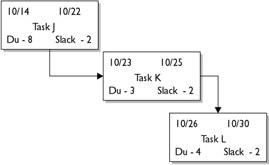Examining the Sequencing Outputs
|
| < Day Day Up > |
|
There are many approaches to using activity sequencing: a project manager and the project team can use software programs, the approach can be done manually, or the team can manually do the scheduling and then transfer the schedule into a PMIS. Whichever method is selected, the project manager must remember four things:
-
Only the required work should be scheduled.
-
Finish-to-start relationships are the most common and preferred.
-
Activity sequencing is not the same as a schedule.
-
Scheduling comes after activity sequencing.
Using a Project Network Diagram
Once the activity list has been put into sequential order, the flow of the project work can be visualized. A project network diagram (PND) illustrates the flow of the project work and the relationship between the work packages. PNDs are typically activity-on-node (AON) and most PMIS packages use the PDM method. The following illustration is typical example of a network diagram.
Network diagrams may also include summary activities, also known as hammock activities. Accompanying the network diagram, there should be an explanation of the workflow, why decisions were made, and details on any preferred logic the project manager may have used. Network diagrams may also be known as a PERT chart, though this term may be slightly inaccurate. PERT, Program Evaluation and Review Technique, is a specific network diagram using weighted averages. (More on PERT in a moment.)

Updating the Activity Lists
During the creation of the network diagram, assumptions about the activity sequence may reveal missing activities in the activity list. Just as the creation of the activity list may prompt the project team and the project manager to update the WBS, the creation of the network diagram may prompt the project team to update the activity lists.
While this may seem redundant, to update the activities list illustrated in the project network diagram, it is essential documentation. A reflection of the WBS, the activity list, and the network diagram should all support the project scope. A key stakeholder should be able to follow the logic of the WBS to the activity list, and from the activity list find all of the activities mapped in order.
|
| < Day Day Up > |
|
EAN: 2147483647
Pages: 209